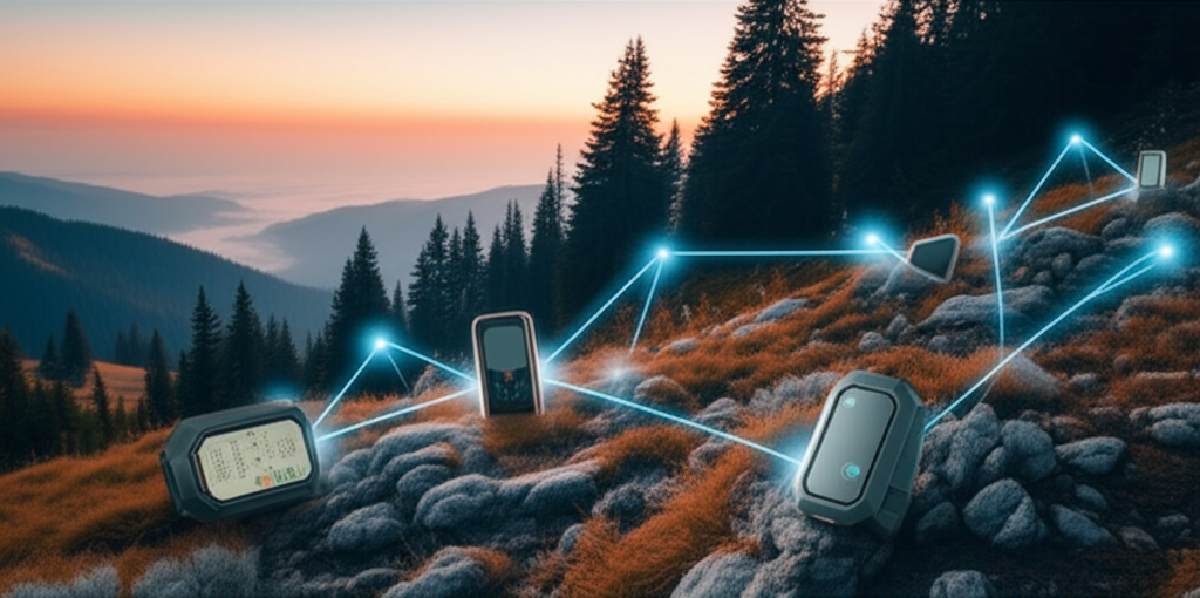Meshtastic is a growing system for off-grid communication. It works without cell towers or the internet. It uses simple, low-cost radios and a special long-range signal called LoRa. This lets devices form a self-healing network. They can send messages and locations over long distances.
Think of it like a chain: each device can pass a message along, helping it travel further. This is great for places where phones don’t work. As we look towards 2025, based on what’s popular and reliable now (early 2025), many good device options are available for everyone, from beginners to experts.
This guide looks at the top Meshtastic devices. We’ll check their features, how well they work, and what users think. This will help you pick the best one for your needs in 2025. We’ll compare popular models based on things like how far they can send messages, how long the battery lasts, size, how easy they are to use, and cost.
How Meshtastic Devices Work #
Meshtastic is built on a simple idea: communication without a central power. It uses open-source software (meaning anyone can see and improve the code) and easy-to-find parts. These parts are usually small computers called microcontrollers (like the ESP32) connected to LoRa radios.
These devices create a mesh network. Each device in the network can receive and forward messages. This helps messages travel around obstacles and reach further. It’s perfect for times when you’re off-grid, preparing for emergencies, hiking, camping, or just want to try out DIY communication tech. The official Meshtastic info and users point out its key features: long range and low power use thanks to LoRa, no need for a central server, and messages are kept private with built-in encryption.
Key Things to Think About When Choosing a Device #
When picking a Meshtastic device, some features really matter for how well it works and how easy it is to use:
- Range: How far can your messages go? This depends on the radio’s power, the quality of the antenna (the part that sends and receives the signal), and the radio frequency allowed in your area.
- Battery Life: How long does it run before needing a charge? This is super important for devices you carry or put in remote spots. It depends on the battery size and how much power the device uses (especially if it has GPS or a screen).
- Durability: Can it handle being used outdoors? Look at the case material and if it can handle water (often you need to add your own case for this). Strong parts mean it lasts longer.
- GPS Accuracy: Many devices can find your location using GPS. This lets you share where you are on the network’s map. How fast and accurately it finds you can vary.
- Ease of Use: How simple is it to set up (like putting the software on it) and use every day? This includes how easy the screen and buttons are, and how well it works with the smartphone app.
Different Kinds of Meshtastic Devices #
Meshtastic hardware comes in different shapes and sizes:
- Handheld Devices: These usually have a screen, buttons, and a battery. They are made for people to carry and use on the go.
- Wearable Devices: These are smaller, maybe worn on your wrist or clipped on. They often have fewer buttons or no screen, relying more on your phone.
- Base Stations: These are meant to stay in one place. They often focus on getting the best range and battery life (maybe using solar power) to act as main points for the network.
Top Meshtastic Devices for 2025: A Closer Look #
Based on what the Meshtastic community liked and used a lot in 2023 and 2024, some devices are great choices for starting or adding to your network. While new ones might appear, these are reliable and well-supported options likely to be popular in 2025.
LILYGO T-Beam Review #
The LILYGO T-Beam is often suggested for people new to Meshtastic. It usually includes the main computer chip (ESP32), a LoRa radio, a GPS chip, and a way to manage battery power. It often uses common 18650 rechargeable batteries, which last a good while.
- Pros: Costs less, easy to find and buy, lots of help from the community, has GPS and battery charging built-in, can get good range.
- Cons: You might need to solder the antenna connector yourself (though some newer ones come ready), usually needs a separate case you print or buy for protection, the screen (if it has one) is basic.
- Key Features: Uses an ESP32 chip, has different LoRa radio options (like SX1276 or the newer SX1262 for better performance), includes GPS (like NEO-6M or NEO-M8N), supports small OLED screens, has a holder for an 18650 battery, and uses a modern USB-C port.
- How it Performs: Known for solid range if you use a good antenna. Battery life is typically very good, especially if you set it up to save power. It can run for many days as a device that just relays messages.
- What Users Say: People really like it for the price and what it does. They find it useful and flexible but mention needing a case and possibly soldering as things to be ready for.
Heltec V3 Review #
The Heltec ESP32 LoRa V3 boards are smaller. They have a screen built-in and sometimes come with a simple case. This makes them more ready to use right out of the box compared to some T-Beam versions.
- Pros: Small size, screen included, often comes with a simple case, good mix of features and price, lots of community help.
- Cons: Uses a smaller battery connector (JST 1.25mm), so you need specific batteries. The screen is quite small.
- Key Features: Uses an ESP32-S3 chip, has the newer SX1262 LoRa radio, includes a small screen, has a USB-C port, uses a JST 1.25mm connector for the battery, available for different radio frequencies.
- How it Performs: Gets good range, similar to other devices with the SX1262 chip. How long the battery lasts depends on the battery size you connect, but the board itself uses power well.
- What Users Say: It’s popular because it’s small and has the screen and case included. Users see it as easier to get started with than basic boards.
RAKwireless WisBlock Review #
The RAKwireless WisBlock system is different. It’s like building with blocks. You pick a main computer board and add other modules for things like the radio, power, or sensors. The RAK4631 is a popular choice for Meshtastic, combining an ESP32-S3, another chip (nRF52840), and the SX1262 radio.
- Pros: You can build exactly what you need by adding modules, the parts are strong and well-made, can get good range, some parts use very little power.
- Cons: Costs more than the T-Beam or Heltec, you have to put the modules together, setting it up can be harder for beginners, you might need extra parts for battery management.
- Key Features: Works with the RAK WisBlock system (you combine CPU, LoRa, Sensor, Power parts), the RAK4631 core uses two main chips (ESP32-S3 and nRF52840), has the SX1262 LoRa radio, offers many ways to power it (like battery or solar), and you can add lots of different sensor modules.
- How it Performs: Known for being reliable and potentially getting better range or using less power because of its design and the chips it uses. Battery life changes a lot based on which power module and battery you choose.
- What Users Say: People who need a tough, custom, or low-power device like the RAK system. They know it costs more and is more complex but feel it’s worth it for the flexibility and quality.
Comparing the Best Meshtastic Devices #
Choosing the right device depends on what’s most important to you. Here’s a quick comparison to help you decide:
- For Beginners / Best Value: The LILYGO T-Beam is often the top pick. It’s affordable, does most things well (GPS, battery), and has a huge community for help. Just be ready to add a case and maybe do a little soldering.
- For Portability / Easier Start: The Heltec V3 is great if you want something smaller and more ready to go out of the box. The built-in screen and optional case make it convenient, though the screen is small and you need specific batteries.
- For Customization / Advanced Users / Base Stations: The RAKwireless WisBlock system offers the most flexibility. If you want to build a specific type of node (like a solar-powered base station or a sensor node) and don’t mind the higher cost and complexity, RAK is an excellent choice for its quality and modularity.
All these devices can provide good range, but performance often comes down to the antenna you use and your location. Battery life varies, but the T-Beam with an 18650 battery generally offers the longest default runtime, while RAK can be optimized for very low power with the right modules.
Which Device Should You Choose? #
Deciding on the best Meshtastic device for 2025 comes down to your needs and comfort level with DIY electronics.
- If you’re just starting out and want to learn without spending too much, the LILYGO T-Beam is a fantastic entry point.
- If you prefer something a bit more polished and compact for handheld use right away, the Heltec V3 is a strong contender.
- If you have specific project ideas, need ruggedness, or want to build a custom setup (like a long-term base station), the RAKwireless WisBlock system gives you the building blocks.
No matter which device you pick, you’ll be joining a growing network of users exploring off-grid communication. The Meshtastic community is a great resource for help, tips, and sharing experiences. Happy Meshing in 2025!

